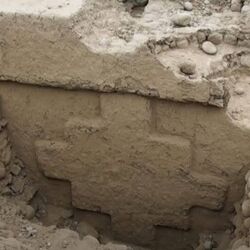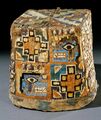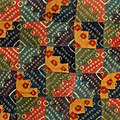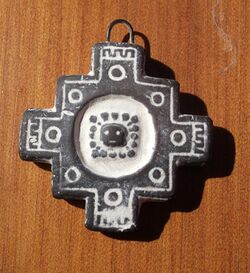Chakana
Topic: Unsolved
 From HandWiki - Reading time: 4 min
From HandWiki - Reading time: 4 min
The Chakana (Andean cross, "stepped cross" or "step motif" or "stepped motif") is a stepped cross motif used by the Inca and pre-incan Andean societies. The most commonly used variation of this symbol today is made up of an equal-armed cross indicating the cardinal points of the compass and a superimposed square. Chakana means 'bridge', and means 'to cross over' in Quechua.[1] The Andean cross motif appears in pre-contact artifacts such as textiles and ceramics from such cultures as the Chavín, Wari, Chancay, and Tiwanaku, but with no particular emphasis and no key or guide to a means of interpretation.[2] The anthropologist Alan Kolata calls the Andean cross "one of the most ubiquitous, if least understood elements in Tiwanaku iconography".[3] The Andean cross symbol has a long cultural tradition spanning 4,000 years up to the Inca Empire.[4]
Andean cross with central eye motif
Ancient Tiwanaku Qirus sometimes bears Andean crosses with central eye motifs.[5] The central eye sometimes is vertically divided. The anthropologist Scott C. Smith interprets the Andean cross motif as a top view of a platform mound (like the Akapana or Pumapunku).[6] According to anthropologist Robin Beck the cross motif in Yaya-Mama stone carving may have been a precursor of the Tiwanaku Andean cross. Beck suggests that the Tiwanaku Andean cross is a representation of a "platform-chamber complex".[7]
Historical evidence
The Andean cross (Chakana) is one of the oldest symbols in the Andes. The oldest complete Chakana was found at an approximately 4,000-year-old temple complex by a team of archaeologists led by archaeologist Pieter Van Dalen.[8] It appears as a prominent element of the decoration of the Tello Obelisk, a decorated monolithic pillar discovered by Peruvian archaeologist Julio C. Tello at the Chavín culture site of Chavín de Huántar. Construction of Chavín de Huántar began around 1200 BCE and the site continued in use to about 400 BCE. The exact date of the Tello Obelisk is not known, but based on its style it probably dates to the middle of this range, around 800 BCE. The form of the Andean cross may be replicated in the Akapana, a large terraced platform mound with a central reservoir built at the site of Tiahuanaco by people of the Tiwanaku culture near Lake Titicaca, Bolivia and dating to about AD 400. Tiwanaku was the center of the Tiwanaku Empire, which thrived in the southern Andes from about 400 to 1000 CE.
The mestizo historian Garcilaso de la Vega, el Ynga, reports about a holy cross of white and red marble or jasper, which was venerated in 16th-century Cusco[citation needed].[9]
The Incas began to venerate the holy cross, after they heard how Pedro de Candia had miraculously defied a lion and a tiger holding a cross. When the Spaniards captured the city, they transferred the cross to sacristy of the newly built cathedral, where De la Vega saw it in 1560. He was surprised that the clergy had not decorated it with gold or gems.[10] Ongoing stories about indigenous crosses contributed to the idea of a 'natural' religion that would have prepared the Indians for their inevitable conversion to Christianity.[11]
"stepped or Andean cross motif"[13] at Kantatayita (Tiwanaku)
Wall of the Six Monoliths at Ollantaytambo with "step motif"[14]
"Andean cross motif"[15] at Iñaq Uyu
The plan of Akapana is often described as "half Andean Cross"[16]
New Age fringe beliefs
The stepped motif has received strong attention from New Age advocates and self proclaimed shamans. They claim a relationship with the constellation of the Southern Cross and that all corners and steps have special symbolic meanings. According to Jessica Joyce Christie the Inka may have shared some of those meanings; however Christie notes that the New Age claim "[...] is purely speculative and unsubstantiated by any historical sources."[17]
References
- ↑ Steven R. Gullberg: Astronomy of the Inca Empire: Use and Significance of the Sun and the Night Sky. Springer Nature, 2020, p. 77.
- ↑ "Images". tocapu.org. http://tocapu.org/images/index.php. Retrieved 2016-12-24.
- ↑ Alan Kolata: The Tiwanaku: portrait of an Andean civilization. Cambridge: Blackwell (1993), ISBN 1-55786-183-8, p. 104
- ↑ "Peruvian archaeologists unearth 4,000-year-old temple" (in en). https://tvpworld.com/69826685/peruvian-archaeologists-unearth-4000-year-old-temple.
- ↑ Smith, S. (2011). "Generative landscapes: the step mountain motif in Tiwanaku iconography.". Ancient America 12: 53.
- ↑ Smith, S. (2011). "Generative landscapes: the step mountain motif in Tiwanaku iconography.". Ancient America 12: 51.
- ↑ Jennifer Birch, ed.: From prehistoric villages to cities: settlement aggregation and community transformation. Routledge, 2014. p. 103
- ↑ Carla Samon Ros: "Andean cross found at Peru temple ruins may be oldest ever" laprensalatina.com. May 15, 2023, Retrieved December 22, 2023.
- ↑ Horner, Channing (2020-08-26). "Comentarios reales de los Incas, Book 2, Chapter 3". https://www.textos.info/inca-garcilaso-de-la-vega/comentarios-reales-de-los-incas/descargar-pdf.
- ↑ Garcillago de la Vega, First part of the Royal Commentaries of the Yncas, 1869, repr. Cambridge 2010, vol. 1, p. 122
- ↑ Simon Ditchfield, ‘What Did Natural History Have to Do with Salvation? José de Acosta SJ (1540-1600) in the America's', in: Peter Clarke and Tony Claydon, God's Bounty? The Churches and the Natural World, Woodbridge, Suffolk and Rochester, NY 2010, pp. 144-168
- ↑ Jean-Pierre Protzen, Stella Nair: The Stones of Tiahuanaco: A Study of Architecture and Construction. vol. 75. Cotsen Institute of Archaeology Press, University of California, Los Angeles 2013, p. 134.
- ↑ Jean-Pierre Protzen, Stella Nair: The Stones of Tiahuanaco: A Study of Architecture and Construction. vol. 75. Cotsen Institute of Archaeology Press, University of California, Los Angeles 2013, p. 134.
- ↑ Jean-Pierre Protzen: Inca Architecture and Construction at Ollantaytambo. Oxford University Press, New York 1993, p. 257
- ↑ Jean-Pierre Protzen, Stella Nair: The Stones of Tiahuanaco: A Study of Architecture and Construction. vol. 75. Cotsen Institute of Archaeology Press, University of California, Los Angeles 2013, p. 132.
- ↑ Alan Kolata: The Tiwanaku: portrait of an Andean civilization. Cambridge: Blackwell (1993), ISBN 1-55786-183-8, p. 104
- ↑ Jessica Joyce Christie: Memory landscapes of the Inka carved outcrops. Lexington Books 2015, p. 219.
Further reading
- Soledad Cachuan: Mitología Inca, Buenos Aires 2008
- Drury: The Elements of Shamanism, Element Books, 1989.
 |
 KSF
KSF













